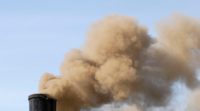The airports across the United States have been using aqueous film-forming foam (AFFF), the premier firefighting foam in the United States for several decades. AFFF contains per- and poly-fluoroalkyl substances (PFASs), which are a large family of man-made fluorinated chemicals with thermal stability that enhances its ability to rapidly extinguish hazardous fires. Though the PFASs increase the principal efficacy of AFFF as a fire suppressant for extinguishing fuel-based fires, the discharge of these agents into the environment poses potentially unacceptable health as well as ecological risk.
PFAS-based AFFF was developed for use on class B fires
Firefighting foams are generally made up of water, air, and foam concentrate. AFFF is synthetic foam consisting of water, solvents with high boiling-point, and fluorochemical/hydrocarbon surfactants that are highly effective and are used to extinguish high-hazard, difficult-to-fight Class B fires arising from petroleum products or flammable liquids or gases such as oil, gasoline, jet fuel, and other fuels. PFASs are the active ingredients in these fluorinated surfactants. The foam concentrates are referred to as “3%” or “6%” concentrates, based on the mixture rate with water. Firefighting foam made of 3% concentrate will contain 97 parts of water and 3 parts of AFFF concentrate. AFFF concentrate will have 60-90% water and 0.3-1.8% fluorine content.
Firefighters use the foam concentrate by mixing it with water and air during use. The foam forms an aqueous film when mixed with water. This film quickly cuts off oxygen to the flame thereby extinguishing the fire and avoiding relighting. Most AFFFs contained perfluorooctanesulphonate (PFOS) and its derivatives. Due to the negative impact created by the discharge of foam solutions into the environment, the 3M company stopped the production of PFOS -based fluorosurfactants in May 2000.
In the last few years, the firefighting industry has withdrawn the use of PFOS and its derivatives and manufacturers have started developing and bringing fluorine-free firefighting foams into the market. These foams potentially have less impact on our environment and tend to meet international standards for firefighting requirements. However, the environmental concerns regarding firefighting foams as well as research about this subject are ongoing.
The military specification for firefighting foams
As per the military specification, the firefighting foams that contained fluorinated surfactants must be added in the Class B foams. All the US military branches were supposed to use fluorinated firefighting foams on their bases located in the US as well as in other countries.
The Federal Aviation Administration (FAA) had incorporated the military specification before 2018. This required the onsite use of fluorinated firefighting foams at major airports in the United States. Local municipalities also use and store AFFF. In the United States, almost 75% of AFFF is used by the military and the remaining 25% is used by organizations including refineries, fuel tank farms, municipal airports, and other industries.
With the recent concerns over perfluorochemical containing firefighting foam, in 2018, the US FAA Reauthorization Act was passed to eliminate the need for fluorinated firefighting foam use at the majority of airports in the US within 3 years. The sale of Class B fluorinated firefighting foams will be banned and Washington is the first state to pass a law and prohibit the sales of the fluorinated firefighting from July 2020. However, the military, petroleum refineries and terminals, FAA-certified airports, and certain chemical plants will remain exempted from it.
AFFF use — concerns elaborated
The major concern around the use of AFFF is the potential negative impact on the environment created as a result of the discharge of foam solutions into the water sources near military bases and the resultant ill-effects to humans. The issues of AFFF contamination include the toxicity, persistence, biodegradability, and treatability in the wastewater treatment plants. When PFAS-containing AFFF is repeatedly used at a place for a long time, the perfluorochemical can get into the soil and then reach the groundwater contaminating the wells located nearby. This is likely to happen near places where PFAS-based AFFF has been used continuously, such as airports, fire training areas, refineries, and chemical plants.
One or more of the below-listed situations result in a discharge of AFFF into the environment:
- Fuel-blanketing operations or manual firefighting
- Training exercises where AFFF is being used
- Fixed system releases
- Foam equipment systems and vehicle tests
- Here is a list of locations where one or more of these scenarios are likely to occur:
- Aircraft facilities
- Firefighter training facilities
- Flammable/hazardous material warehouses
- Bulk flammable liquid storage facilities
- Hazardous waste storage facilities
- Oil and gas industries
Workers are exposed to PFAS in AFFF
Workplace exposure to PFAS occurs primarily through inhalation of the spray mist and dust contaminated with PFAS. Absorption of liquid PFAS through the skin is slow and thus exposure via skin contact is negligible. Studies suggest that the people who work at places where PFAS is manufactured or else used in raw form have higher levels of PFOS and PFOA in their blood.
How can workers reduce their risk of exposure to PFAS present in AFFF?
The risk of PFAS exposure at the workplace should be minimized wherever possible, and in situations where complete elimination is not feasible, the risk of exposure needs to be assessed and managed well according to the hierarchy of exposure controls. It is important to consider the safe work procedures and the recommendations mentioned in the Safety Data Sheets (SDS). Along with personal protective equipment (PPE), which is just a low level of control, it is important to consider other options:
In firefighting: Firefighters are exposed to PFAS-based AFFF as well as other chemicals during firefighting situations. It is therefore recommended to wear a full structural firefighting uniform that includes gloves and respiratory protection at all times.
Handling spills, decontamination, and disposal: Firefighters involved in decanting and pouring PFAS-based AFFF or workers involved in decontamination of firefighting equipment and accidental spills of AFFF should wear a minimum level of personal protective clothing and equipment that includes rubber gloves, P2 respirators, duty wears, and splash-proof goggles at all times.
Studies suggest that there is a link between PFAS exposure and cancer affecting the kidney, bladder, and testes. PFOA and PFOS are believed to be endocrine disruptors. Generally, military members, firefighters, chemical plant workers, airport workers, and AFFF manufacturers are at the highest risk of being exposed to the toxic AFFF. People with this occupational exposure may be entitled to file a lawsuit if they receive a diagnosis of cancer of the kidney, pancreas or testes later in their life.



